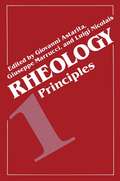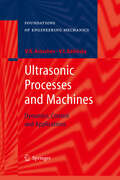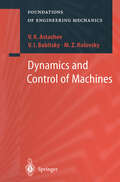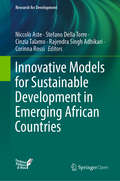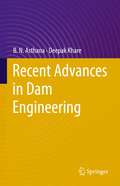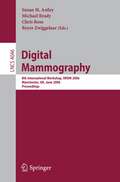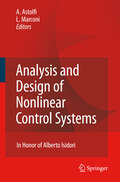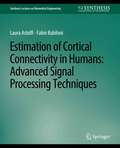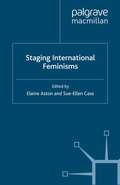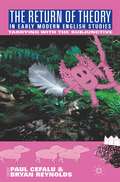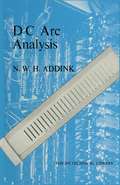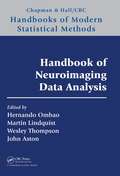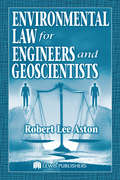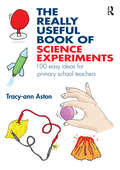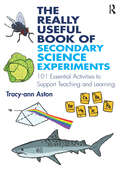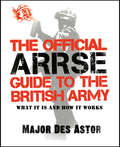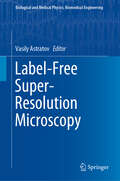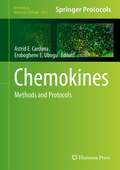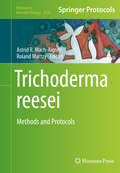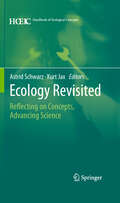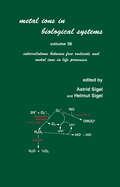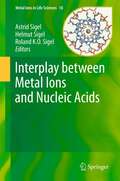- Table View
- List View
Rheology: Volume 1: Principles
by Giovanni Astarita Giuseppe Marrucci Luigi NicolaisAt the VIIth International Congress on Rheology, which was held in Goteborg in 1976, Proceedings were for the first time printed in advance and distributed to all participants at the time of the Congress. Although of course we Italians would be foolish to even try to emulate our Swedish friends as far as efficiency of organization is concerned, we decided at the very beginning that, as far as the Proceedings were concerned, the VIIIth International Congress on Rheology in Naples would follow the standards of time liness set by the Swedish Society of Rheology. This book is the result we have obtained. We wish to acknowledge the cooperation of Plenum Press in producing it within the very tight time schedule available. Every four years, the International Congress on Rheology represents the focal point where all rheologists meet, and the state of the art is brought up to date for everybody interested; the Proceedings represent the written record of these milestones of scientific progress in rheology. We have tried to make use of the traditions of having invited lectures, and of leaving to the organizing committee the freedom to choose the lecturers as they see fit, in order to collect a group of invited lectures which gives as broad as possible a landscape of the state of the art in every relevant area of rheology. The seventeen invited lectures are collected in the first volume of the proceedings.
Ultrasonic Processes and Machines: Dynamics, Control and Applications (Foundations of Engineering Mechanics)
by V.K. Astashev V. I. BabitskyThis work is the first and only book on the fundamentals of ultrasonic machining. It presents the foundations of dynamic and control for ultrasonic processing systems and considers ultrasonic systems as special vibratory machines that function by exploiting nonlinear dynamic processes. Recommendations are given for designing and tuning ultrasonic machines. The ultrasonic machines analyzed are predominantly concerned with the processing of solids.
Dynamics and Control of Machines (Foundations of Engineering Mechanics)
by V.K. Astashev V.I. Babitsky M.Z. KolovskyBasic models and concepts of machine dynamics and motion control are presented in the order of the principal steps of machine design. The machine is treated as a coupled dynamical system, including drive, mechanisms and controller, to reveal its behavior at different regimes through the interaction of its units under dynamic and processing loads. The main dynamic effects in machines are explained. The influence of component compliances on accuracy, stability and efficiency of the machines is analyzed. Methods for decreasing internal and external vibration activity of machines are described. The dynamic features of digital control are considered. Special attention is given to machines with intense dynamic behavior: resonant and hand-held percussion ones. Targeted to engineers as well as to lecturers and advanced students.
Innovative Models for Sustainable Development in Emerging African Countries (Research for Development)
by Niccolò Aste Stefano Della Torre Cinzia Talamo Rajendra Singh Adhikari Corinna RossiThis open access book explores key issues and presents recent case studies in areas of importance for the transition to a circular model of development in emerging African countries that will minimize resource consumption and waste production. The topics covered include the development of sustainable housing models, energy and environmental issues in building design and technical systems, recycling for a sustainable future, models for humanitarian emergencies, and low-cost and web-based digital tools with applications in architecture and archaeology. The aim is to contribute to a necessary paradigm shift with respect to urban planning and usage of territories, moving from a linear urban metabolism based on the “take, make, dispose” approach to a circular metabolism. Such a change requires a focus on the relationship between the architectural, urban, and physical aspects of new developments, climate, and energy demand, as well as the identification and integration of strategies and infrastructures to achieve a high level of efficiency and self-sufficiency. The book will appeal to all with an interest in sustainable development in the African context.
Recent Advances in Dam Engineering
by B.N. Asthana Deepak KhareThis book discusses recent developments in dam engineering, covering theoretical as well as practical aspects. The chapters provide detailed descriptions of the types, surveys and investigations, layouts, design, thermal stresses and foundation of dams. The differences between various theories/methods of analysis used in design and their practical application and limitations are clarified.The book focuses on earth fills and landfills and stresses the importance of the foundation treatment. Failure of embankment dams is discussed particularly in the planning and construction stages of the dam. The environmental impact of dams is treated with references to river diversions and reservoir sedimentation. The book is written as a reference book for professional engineers and is also suitable for post graduate courses.
Digital Mammography: 8th International Workshop, IWDM 2006, Manchester, UK, June 18-21, 2006, Proceedings (Lecture Notes in Computer Science #4046)
by Susan M. Astley Michael Brady Chris Rose Reyer ZwiggelaarThis book constitutes the refereed proceedings of the 8th International Workshop on Digital Mammography, IWDM 2006, held in Manchester, UK, June 2006. The book presents 52 revised full papers and 34 revised poster papers, organized in topical sections on breast density, CAD, clinical practice, tomosynthesis, registration and multiple view mammmography, physics models, wavelet methods, full-field digital mammography, and segmentation.
Analysis and Design of Nonlinear Control Systems: In Honor of Alberto Isidori
by Alessandro Astolfi Lorenzo MarconiThis book is a tribute to Prof. Alberto Isidori on the occasion of his 65th birthday. Prof. Isidori’s proli?c, pioneering and high-impact research activity has spanned over 35 years. Throughout his career, Prof. Isidori has developed ground-breaking results, has initiated researchdirections and has contributed towardsthe foundationofnonlinear controltheory.In addition,his dedication to explain intricate issues and di?cult concepts in a simple and rigorous way and to motivate young researchers has been instrumental to the intellectual growth of the nonlinear control community worldwide. The volume collects 27 contributions written by a total of 52 researchers. The principal author of each contribution has been selected among the - searchers who have worked with Prof. Isidori, have in?uenced his research activity, or have had the privilege and honour of being his PhD students. The contributions address a signi?cant number of control topics, including th- retical issues, advanced applications, emerging control directions and tutorial works. The diversity of the areas covered, the number of contributors and their international standing provide evidence of the impact of Prof. Isidori in the control and systems theory communities. The book has been divided into six parts: System Analysis, Optimization Methods, Feedback Design, Regulation, Geometric Methods and Asymptotic Analysis, re?ecting important control areas which have been strongly in- enced and, in some cases, pioneered by Prof. Isidori.
Estimation of Cortical Connectivity in Humans: Advanced Signal Processing Techniques (Synthesis Lectures on Biomedical Engineering)
by Laura Astolfi Fabio BabiloniIn the last ten years many different brain imaging devices have conveyed a lot of information about the brain functioning in different experimental conditions. In every case, the biomedical engineers, together with mathematicians, physicists and physicians are called to elaborate the signals related to the brain activity in order to extract meaningful and robust information to correlate with the external behavior of the subjects. In such attempt, different signal processing tools used in telecommunications and other field of engineering or even social sciences have been adapted and re-used in the neuroscience field. The present book would like to offer a short presentation of several methods for the estimation of the cortical connectivity of the human brain. The methods here presented are relatively simply to implement, robust and can return valuable information about the causality of the activation of the different cortical areas in humans using non invasive electroencephalographic recordings. The knowledge of such signal processing tools will enrich the arsenal of the computational methods that a engineer or a mathematician could apply in the processing of brain signals. Table of Contents: Introduction / Estimation of the Effective Connectivity from Stationary Data by Structural Equation Modeling / Estimation of the Functional Connectivity from Stationary Data by Multivariate Autoregressive Methods / Estimation of Cortical Activity by the use of Realistic Head Modeling / Application: Estimation of Connectivity from Movement-Related Potentials / Application to High-Resolution EEG Recordings in a Cognitive Task (Stroop Test) / Application to Data Related to the Intention of Limb Movements in Normal Subjects and in a Spinal Cord Injured Patient / The Instantaneous Estimation of the Time-Varying Cortical Connectivity by Adaptive Multivariate Estimators / Time-Varying Connectivity from Event-Related Potentials
Staging International Feminisms (Studies in International Performance)
by E. Aston S. CaseThis is a landmark anthology of international feminist theatre research. A three-part structure orientates readers through Cartographies of feminist critical navigations of the global arena; the staging of feminist Interventions in a range of international contexts; and Manifestos for today's feminist practitioners, activists and academics.
The Return of Theory in Early Modern English Studies: Tarrying with the Subjunctive
by E. Aston B. Reynolds Paul CefaluThis collection looks at the growing rapprochement between contemporary theory and early modern English literary-cultural studies. With sections on posthumanism and cognitive science, political theology, and rematerialism and performance, the essays incorporate recent theoretical inquiries into new readings of early modern texts.
Handbook of Neuroimaging Data Analysis (Chapman & Hall/CRC Handbooks of Modern Statistical Methods)
by John Aston Hernando Ombao Martin Lindquist Wesley ThompsonThis book explores various state-of-the-art aspects behind the statistical analysis of neuroimaging data. It examines the development of novel statistical approaches to model brain data. Designed for researchers in statistics, biostatistics, computer science, cognitive science, computer engineering, biomedical engineering, applied mathematics, physics, and radiology, the book can also be used as a textbook for graduate-level courses in statistics and biostatistics or as a self-study reference for Ph.D. students in statistics, biostatistics, psychology, neuroscience, and computer science.
Environmental Law for Engineers and Geoscientists
by Robert Lee AstonToday’s engineering and geoscience student needs to know more than how to design a new or remedial project or facility. Questions of law and ambiguities of terms often occur in contracts for mining, landfills, site reclamation, waste depositories, clean up sites, land leases, operating agreements, joint ventures, and other projects. Work place situations arise where environmental compliance methods are challenged by enforcement agencies. Although the statutes, rules, and regulations may seem to be worded clearly and specifically, there are often questions in application and sometimes varied interpretations. Environmental Law for Engineers and Geoscientists introduces simplified American jurisprudence focusing on the legal system, its courts, terms, phrases, administrative law, and regulation by the agencies that administer environmental law. The book comprehensively covers the “big five” environmental statutes: NEPA, CAA, CWA, CERCLA, and RCRA. With the basic law chapter as a foundation, the book covers the practical applications of environmental law for geo-engineers. It concludes with a chapter on the growing area of expert witnessing and admissible evidence in environmental litigation — an area of law where success or failure increasingly depends on the exacting preparation and presentation of expert scientific evidence. Written by a professional mining and geological engineer and a practicing attorney, Environmental Law for Engineers and Geoscientists prepares students for the numerous environmental regulatory encounters they can expect when dealing with various statutes, laws, regulations, and agency rules that govern, affect, and apply to environmental engineering projects. It provides a working knowledge of how to judge whether or not a project is in compliance with regulations, and how to ensure that it is.
Environmental Law for Engineers and Geoscientists
by Robert Lee AstonToday’s engineering and geoscience student needs to know more than how to design a new or remedial project or facility. Questions of law and ambiguities of terms often occur in contracts for mining, landfills, site reclamation, waste depositories, clean up sites, land leases, operating agreements, joint ventures, and other projects. Work place situations arise where environmental compliance methods are challenged by enforcement agencies. Although the statutes, rules, and regulations may seem to be worded clearly and specifically, there are often questions in application and sometimes varied interpretations. Environmental Law for Engineers and Geoscientists introduces simplified American jurisprudence focusing on the legal system, its courts, terms, phrases, administrative law, and regulation by the agencies that administer environmental law. The book comprehensively covers the “big five” environmental statutes: NEPA, CAA, CWA, CERCLA, and RCRA. With the basic law chapter as a foundation, the book covers the practical applications of environmental law for geo-engineers. It concludes with a chapter on the growing area of expert witnessing and admissible evidence in environmental litigation — an area of law where success or failure increasingly depends on the exacting preparation and presentation of expert scientific evidence. Written by a professional mining and geological engineer and a practicing attorney, Environmental Law for Engineers and Geoscientists prepares students for the numerous environmental regulatory encounters they can expect when dealing with various statutes, laws, regulations, and agency rules that govern, affect, and apply to environmental engineering projects. It provides a working knowledge of how to judge whether or not a project is in compliance with regulations, and how to ensure that it is.
The Really Useful Book of Science Experiments: 100 easy ideas for primary school teachers (The Really Useful)
by Tracy-ann AstonThe Really Useful Book of Science Experiments contains 100 simple-to-do science experiments that can be confidently carried out by any teacher in a primary school classroom with minimal (or no!) specialist equipment needed. The experiments in this book are broken down into easily manageable sections including: It’s alive: experiments that explore our living world, including the human body, plants, ecology and disease A material world: experiments that explore the materials that make up our world and their properties, including metals, acids and alkalis, water and elements Let’s get physical: experiments that explore physics concepts and their applications in our world, including electricity, space, engineering and construction Something a bit different: experiments that explore interesting and unusual science areas, including forensic science, marine biology and volcanology. Each experiment is accompanied by a ‘subject knowledge guide’, filling you in on the key science concepts behind the experiment. There are also suggestions for how to adapt each experiment to increase or decrease the challenge. The text does not assume a scientific background, making it incredibly accessible, and links to the new National Curriculum programme of study allow easy connections to be made to relevant learning goals. This book is an essential text for any primary school teacher, training teacher or classroom assistant looking to bring the exciting world of science alive in the classroom.
The Really Useful Book of Science Experiments: 100 easy ideas for primary school teachers (The Really Useful)
by Tracy-ann AstonThe Really Useful Book of Science Experiments contains 100 simple-to-do science experiments that can be confidently carried out by any teacher in a primary school classroom with minimal (or no!) specialist equipment needed. The experiments in this book are broken down into easily manageable sections including: It’s alive: experiments that explore our living world, including the human body, plants, ecology and disease A material world: experiments that explore the materials that make up our world and their properties, including metals, acids and alkalis, water and elements Let’s get physical: experiments that explore physics concepts and their applications in our world, including electricity, space, engineering and construction Something a bit different: experiments that explore interesting and unusual science areas, including forensic science, marine biology and volcanology. Each experiment is accompanied by a ‘subject knowledge guide’, filling you in on the key science concepts behind the experiment. There are also suggestions for how to adapt each experiment to increase or decrease the challenge. The text does not assume a scientific background, making it incredibly accessible, and links to the new National Curriculum programme of study allow easy connections to be made to relevant learning goals. This book is an essential text for any primary school teacher, training teacher or classroom assistant looking to bring the exciting world of science alive in the classroom.
The Really Useful Book of Secondary Science Experiments: 101 Essential Activities to Support Teaching and Learning (The Really Useful)
by Tracy-ann AstonHow can a potato be a battery? How quickly will a shark find you? What food should you take with you when climbing a mountain? The Really Useful Book of Secondary Science Experiments presents 101 exciting, ‘real-world’ science experiments that can be confidently carried out by any KS3 science teacher in a secondary school classroom. It offers a mix of classic experiments together with fresh ideas for investigations designed to engage students, help them see the relevance of science in their own lives and develop a passion for carrying out practical investigations. Covering biology, chemistry and physics topics, each investigation is structured as a problem-solving activity, asking engaging questions such as, ‘How can fingerprints help solve a crime?’, or ‘Can we build our own volcano?’ Background science knowledge is given for each experiment, together with learning objectives, a list of materials needed, safety and technical considerations, detailed method, ideas for data collection, advice on how to adapt the investigations for different groups of students, useful questions to ask the students and suggestions for homework. Additionally, there are ten ideas for science based projects that can be carried out over a longer period of time, utilising skills and knowledge that students will develop as they carrying out the different science investigations in the book. The Really Useful Book of Secondary Science Experiments will be an essential source of support and inspiration for all those teaching in the secondary school classroom, running science clubs and for parents looking to challenge and excite their children at home.
The Really Useful Book of Secondary Science Experiments: 101 Essential Activities to Support Teaching and Learning (The Really Useful)
by Tracy-ann AstonHow can a potato be a battery? How quickly will a shark find you? What food should you take with you when climbing a mountain? The Really Useful Book of Secondary Science Experiments presents 101 exciting, ‘real-world’ science experiments that can be confidently carried out by any KS3 science teacher in a secondary school classroom. It offers a mix of classic experiments together with fresh ideas for investigations designed to engage students, help them see the relevance of science in their own lives and develop a passion for carrying out practical investigations. Covering biology, chemistry and physics topics, each investigation is structured as a problem-solving activity, asking engaging questions such as, ‘How can fingerprints help solve a crime?’, or ‘Can we build our own volcano?’ Background science knowledge is given for each experiment, together with learning objectives, a list of materials needed, safety and technical considerations, detailed method, ideas for data collection, advice on how to adapt the investigations for different groups of students, useful questions to ask the students and suggestions for homework. Additionally, there are ten ideas for science based projects that can be carried out over a longer period of time, utilising skills and knowledge that students will develop as they carrying out the different science investigations in the book. The Really Useful Book of Secondary Science Experiments will be an essential source of support and inspiration for all those teaching in the secondary school classroom, running science clubs and for parents looking to challenge and excite their children at home.
The Official ARRSE Guide to the British Army
by Major Des AstorHow will we defeat the Taleban and bring peace to Afghanistan? What will the British soldier of the late 21st century look like? When will the next World War break out?We're damned if we know, but if you want to find out what today's British Army is really like, then The Official Arrse Guide to the British Army is the book for you. Drawn from the wit and wisdom of the ARmy Rumour Service, Britain's biggest and most active military website, the Official Arrse Guide gives the inside track on all aspects of modern British military life. How do I join? Where will I be sent? What's the hardware like? What exactly is it that clerks put in staff officers' coffee? Why do the RAF wear uniforms? Where can I get a decent pair of boots? Is there any meat in an army sausage? All these crucial questions - and more - are answered in The Official Arrse Guide.
Label-Free Super-Resolution Microscopy (Biological and Medical Physics, Biomedical Engineering)
by Vasily AstratovThis book presents the advances in super-resolution microscopy in physics and biomedical optics for nanoscale imaging. In the last decade, super-resolved fluorescence imaging has opened new horizons in improving the resolution of optical microscopes far beyond the classical diffraction limit, leading to the Nobel Prize in Chemistry in 2014. This book represents the first comprehensive review of a different type of super-resolved microscopy, which does not rely on using fluorescent markers. Such label-free super-resolution microscopy enables potentially even broader applications in life sciences and nanoscale imaging, but is much more challenging and it is based on different physical concepts and approaches. A unique feature of this book is that it combines insights into mechanisms of label-free super-resolution with a vast range of applications from fast imaging of living cells to inorganic nanostructures. This book can be used by researchers in biological and medical physics. Due to its logically organizational structure, it can be also used as a teaching tool in graduate and upper-division undergraduate-level courses devoted to super-resolved microscopy, nanoscale imaging, microscopy instrumentation, and biomedical imaging.
Chemokines: Methods and Protocols (Methods in Molecular Biology #1013)
by Astrid E. Cardona and Eroboghene E. UboguChemokines constitute a large family of structurally similar cytokines that contain a signature of conserved cysteine residues joined by disulfide bridges. Binding of chemokines to specific G protein-coupled receptors followed by downstream signaling defines their biological function. Initially, chemoattraction was the key function linked to chemokines/chemokine receptors; however, in recent years, it has become clear that chemokine ligand-receptor interactions can also modulate cellular activation, survival, and proliferation, among other functions in homeostatic and diseased states. Importantly, major advances in our understanding of chemokine biology have led to chemokine receptors becoming specific therapeutic targets with great potential. In Chemokines: Methods and Protocols, expert researchers provide practical information regarding experimental models and state of the art protocols used to delineate chemokine/chemokine receptor function and their applications in health and disease. Written in the highly successful Methods in Molecular Biology series format, chapters include introductions to their respective topics, lists of the necessary materials and reagents, step-by-step, readily reproducible laboratory protocols, and tips on troubleshooting and avoiding known pitfalls. Practical and easy to use, Chemokines: Methods and Protocols aims to reveal key protocols of functional and descriptive chemokine ligand/receptor assays that will be of practical significance to graduate students, post-doctoral fellows, trainees, and researchers in academia and industry.
Trichoderma reesei: Methods and Protocols (Methods in Molecular Biology #2234)
by Astrid R. Mach-Aigner Roland MartzyThis detailed book collects standard techniques and cutting-edge methods that are frequently used by the research community studying the fungus Trichoderma reesei. Beginning with overviews of its evolution, its use in the production of industrially-relevant enzymes, and synthetic biology applications, the volume continues with methods covering topics from transformation techniques and gene editing to downstream-analytical applications and -omics analyses and the corresponding bioinformatics approaches. Written for the highly successful Methods in Molecular Biology series, chapters include introductions to their respective topics, lists of the necessary materials and reagents, step-by-step, readily reproducible laboratory protocols, and tips on troubleshooting and avoiding known pitfalls. Authoritative and practical, Trichoderma reesei: Methods and Protocols serves as an ideal guide for a wide range of audiences, from students who want to familiarize themselves with basic research protocols to experienced scientists who are planning to establish a new method in their laboratories, working with this dynamic fungus.
Ecology Revisited: Reflecting on Concepts, Advancing Science
by Astrid Schwarz and Kurt JaxAs concerns about humankind’s relationship with the environment move inexorably up the agenda, this volume tells the story of the history of the concept of ecology itself and adds much to the historical and philosophical debate over this multifaceted discipline. The text provides readers with an overview of the theoretical, institutional and historical formation of ecological knowledge. The varied local conditions of early ecology are considered in detail, while epistemological problems that lie on the borders of ecology, such as disunity and complexity, are discussed. The book traces the various phases of the history of the concept of ecology itself, from its 19th century origins and antecedents, through the emergence of the environmental movement in the later 20th century, to the future, and how ecology might be located in the environmental science framework of the 21st century. The study of ‘ecological’ phenomena has never been confined solely to the work of researchers who consider themselves ecologists. It is rather a field of knowledge in which a plurality of practices, concepts and theories are developed. Thus, there exist numerous disciplinary subdivisions and research programmes within the field, the boundaries of which remain blurred. As a consequence, the deliberation to adequately identify the ecological field of knowledge, its epistemic and institutional setting, is still going on. This will be of central importance not only in locating ecology in the frame of 21st century environmental sciences but also for a better understanding of how nature and culture are intertwined in debates about pressing problems, such as climate change, the protection of species diversity, or the management of renewable resources.
Metal Ions in Biological Systems: Volume 36: Interrelations Between Free Radicals and Metal Ions in Life Processes
by Astrid Sigel and Helmut SigelContinues the tradition of excellence established in previous volumes in this acclaimed series. Volume 36 focuses on the vibrant research area concerning the interrelation between free radicals and metal ions and their resulting effects on life processes; it offers an authoritative and timely account of this fascinating area of research in 21 chapters.
Interplay between Metal Ions and Nucleic Acids (Metal Ions in Life Sciences #10)
by Astrid Sigel, Helmut Sigel and Roland K. O. SigelInterplay between Metal Ions and Nucleic Acids provides in an authoritative and timely manner in 12 stimulating chapters, written by 24 internationally recognized experts from 8 nations, and supported by nearly 1500 references, about 20 tables, and 125 illustrations, many in color, a most up-to-date view on metal ion-nucleic acid interactions; the characterization of which is covered in solution and in the solid state. The volume concentrates on modern developments encompassing topics in the wide range from G-quadruplexes via DNAzymes, catalysis at the DNA scaffold, and metal-mediated base pairs to peptide nucleic acids (PNAs) being thus of relevance, e.g., for chemistry and nanotechnology but also for molecular biology and (genetic) diagnostics.
